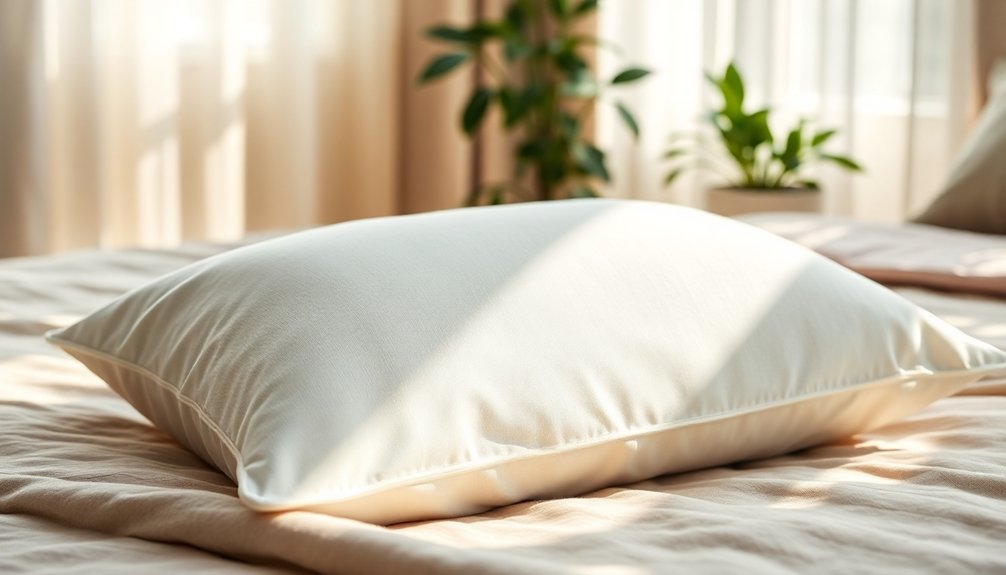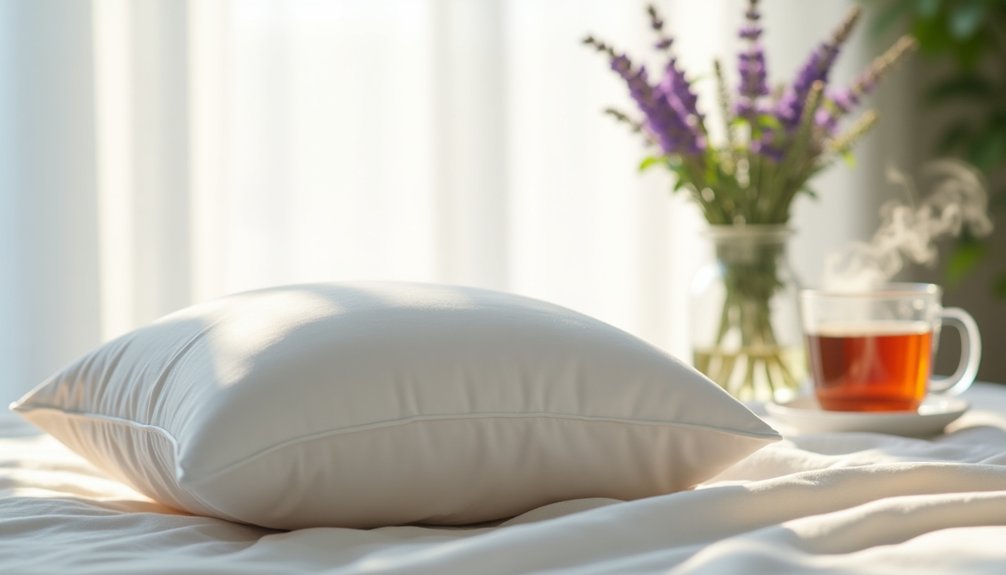Polypropylene pillows are generally safe, as they're non-toxic and free from harmful substances like BPA. However, concerns about allergies and off-gassing still exist. Allergens such as dust mites can accumulate in pillows, potentially triggering sensitivities. While polypropylene emits fewer VOCs than some materials, off-gassing can still occur, impacting indoor air quality. To minimize these risks, opt for hypoallergenic covers and maintain regular cleaning routines. It's wise to look for certifications like CertiPUR-US to ensure safety. If you want to make well-informed choices, there's more to uncover about the benefits and precautions regarding polypropylene pillows.
Key Takeaways
- Polypropylene is non-toxic, FDA-approved for food use, and emits no VOCs, making it generally safe for pillows.
- Allergens such as dust mites and flame retardants may still be present in polypropylene pillows, potentially causing allergic reactions.
- Off-gassing from polypropylene occurs at lower rates than more toxic plastics, but can still affect indoor air quality.
- Regular cleaning and hypoallergenic materials in pillow construction can help mitigate allergen exposure and sensitivities.
- Proper disposal and certification, like CertiPUR-US, ensure the safety and low VOC emissions of polypropylene pillows.
Overview of Polypropylene Safety
When it comes to polypropylene safety, you can feel reassured knowing that this material is generally non-toxic and approved by health authorities like the FDA and EFSA for food-related uses.
Classified as non-hazardous under EC 1272/2008, polypropylene is a versatile choice widely used in food containers, medical supplies, and fabrics. Its safety profile extends to being BPA-free, so you won't have to worry about potential hormonal disruptions commonly associated with that chemical.
Moreover, polypropylene doesn't emit volatile organic compounds (VOCs) or formaldehyde, making it less likely to cause respiratory issues or irritation. Polypropylene also has a high melting point of approximately 160°C heat resistance, which makes it suitable for various applications. While polypropylene has a low chemical emission profile, it's important to note that there are still unknowns regarding certain additives used in its production, such as stabilizers and dyes. Furthermore, though it's stable under normal conditions, heating polypropylene can release harmful chemicals.
Given that pillows can accumulate allergens over time if not regularly maintained, it is crucial to ensure a clean sleep environment when using pillows made from polypropylene.
Allergic Reactions and Sensitivities
Polypropylene pillows offer comfort and safety, but it's essential to be aware of potential allergic reactions and sensitivities associated with various materials and additives. Common allergens found in pillows include dust mites, flame retardants, pesticides, and formaldehyde, all of which can trigger respiratory issues and skin irritation. Exposure to microplastic particles can also exacerbate respiratory problems, especially for people with pre-existing conditions. It's essential to note that polyester allergy can also arise from synthetic materials used in some pillow fillings.
If you're sensitive to these substances, you might experience symptoms like redness, itching, or even breathing difficulties. You should also consider that fragrances and chemical additives can exacerbate headaches and sore throats, especially if you have allergies or asthma. To minimize these risks, choose pillows made from hypoallergenic materials and regularly wash your bedding in hot water to eliminate dust mites.
Avoiding allergens is crucial, so always check fabric content labels before purchasing. If you suspect an allergy, skin and blood tests can help identify specific triggers. Over-the-counter medications like antihistamines can provide relief, but in severe cases, prescription treatments might be necessary. By maintaining a clean bedroom environment and encasing your mattress, you can significantly reduce your exposure to allergens and enjoy a more restful sleep.
Understanding Off-Gassing

Off-gassing refers to the release of volatile organic compounds (VOCs) from various household products, which can significantly impact your indoor air quality. This process happens primarily with newly manufactured items, as chemicals trapped during production are gradually released. Common examples include the "new car smell" and odors from furniture or mattresses. In addition, proper ventilation is particularly important in greenhouses with plastic coverings, as they can also contribute to VOCs.
| Aspect | Details |
|---|---|
| Definition | Release of VOCs into the air |
| Health Risks | Respiratory issues, skin irritation, and headaches |
| Common Sources | Furniture, mattresses, carpets, and electronics |
| Duration | Off-gassing can last from days to years |
Indoor air often contains VOC concentrations that are ten times higher than those outdoors, raising significant health concerns. Inhaling these compounds can lead to allergic reactions and other serious health issues, including respiratory problems and potential long-term damage. To mitigate these risks, consider using green-certified products and ensuring proper ventilation in your space. New appliances and electronic products tend to off-gas due to absorbed chemicals during manufacturing. By being aware of off-gassing, you can take steps to improve your indoor environment and safeguard your health.
Environmental Concerns With Polypropylene
Indoor air quality is just one aspect of the broader environmental concerns surrounding polypropylene. The manufacturing process releases significant greenhouse gases and contributes to fossil resource depletion, indicating a high global warming potential. Polypropylene offgasses at lower rates than more toxic plastics, which can make it a relatively safer choice for certain applications.
You should also consider the potential human toxicity associated with these emissions, which can harm both human health and the environment.
When it comes to waste management, landfilling polypropylene poses severe risks, including the release of cadmium, a carcinogen that threatens plants and wildlife.
Although polypropylene is fully recyclable, challenges in recycling mean that much of it ends up in landfills or, worse, oceans, where it contributes to microplastic pollution.
During its lifecycle, polypropylene has a notable energy consumption profile, yet its long-term decomposition spans hundreds of years, further exacerbating environmental pollution.
The material's widespread use in products like food packaging and textiles only increases its ecological footprint.
Additionally, burning polypropylene releases toxic emissions, presenting another layer of environmental threat.
As you weigh your choices, remember that the environmental impact of polypropylene extends far beyond its immediate use.
Recommendations for Safe Use

When using polypropylene pillows, safety should be a top priority. To ensure safe handling and hygiene, wear protective gloves when handling the pillow and wash your hands thoroughly afterward. Avoid eating, drinking, or smoking around the pillow to minimize contamination. If the pillow comes into contact with a liquid, refer to the safety data sheet for guidance. Additionally, consider using a waterproof allergy protection pillow protector to further safeguard your pillow from allergens and spills. When it comes to storing and reheating food, consider using alternative containers made of glass or ceramic materials to minimize the risk of chemical leaching.
For fire safety, avoid breathing in smoke or vapors during any fire incident. Always use protective equipment if you're in a firefighting situation and never touch spilled materials. Flush any burns caused by heat exposure with water and seek medical attention immediately.
Environmental precautions are also vital. Don't discharge pillows into drains or watercourses and ensure proper disposal according to local regulations.
Lastly, to help prevent allergies, choose hypoallergenic materials and use dust-proof encasements. A zippered closure on your pillow protector can help keep allergens at bay.
| Recommendation | Description |
|---|---|
| Handling & Hygiene | Wear gloves and wash hands after use. |
| Fire Safety | Use protective gear and avoid inhaling smoke. |
| Allergy Prevention | Use hypoallergenic materials and encasements. |
Importance of Certifications
Choosing polypropylene pillows that are certified can significantly enhance safety and quality. Certifications like CertiPUR-US ensure that the materials used are free from harmful chemicals and meet strict safety standards. This not only protects your health but also contributes to better indoor air quality. Additionally, CertiPUR-US represents the industry's most rigorous certification for foam products, providing peace of mind to consumers. Opting for certified pillows also supports the use of more sustainable materials, such as bioplastics, which can reduce our overall carbon footprint.
When considering certified pillows, look for the following key factors:
- Chemical Safety Standards: Ensure they're free from formaldehyde, ozone depleters, phthalates, and heavy metals.
- Low VOC Emissions: Check for low volatile organic compound emissions, which promote healthier air.
- Environmental Considerations: Certified foams use non-toxic materials, supporting a healthier environment.
- Industry Recognition: CertiPUR-US is widely recognized as a leading certification program, ensuring impartiality and transparency.
Making Informed Choices

Making informed choices about polypropylene pillows requires a clear understanding of their composition and potential health impacts. Polypropylene, a durable plastic, can contain chemical additives that may have uncertain long-term health effects, particularly when exposed to heat. This raises concerns about off-gassing, where harmful chemicals, including formaldehyde, could leach into the air, affecting indoor air quality. Furthermore, the non-biodegradable nature of polypropylene contributes to plastic pollution and environmental degradation.
When it comes to allergies, know that polypropylene pillows aren't inherently resistant to dust mites, mold, or mildew. These allergens can accumulate, potentially leading to respiratory issues. Regularly vacuuming and washing your pillows can help mitigate these risks, but you might want to consider hypoallergenic materials if allergies are a concern. In fact, some materials marketed as hypoallergenic properties may not perform as expected when it comes to dust mite resistance.
Finally, be aware of the environmental impacts. Polypropylene contributes to microplastic pollution and presents recycling challenges. To lessen your ecological footprint, opt for reusable alternatives whenever possible.
Frequently Asked Questions
Can Polypropylene Pillows Be Washed and Dried Safely?
Yes, you can wash and dry polypropylene pillows safely. Just follow the care instructions, use a gentle cycle in a front-loading machine, and dry on low heat to maintain their shape and integrity.
How Do Polypropylene Pillows Compare to Natural Fiber Pillows?
When you compare polypropylene pillows to natural fiber ones, you'll notice polypropylene retains heat, may trigger allergies, and can lose shape. Natural fibers, however, offer breathability, hypoallergenic properties, and long-lasting support for better comfort.
What Are the Common Signs of an Allergic Reaction to Polypropylene?
If you're allergic to polypropylene, you might experience itching, redness, hives, nasal congestion, or even asthma symptoms. Recognizing these signs is crucial, so consult a healthcare professional for proper diagnosis and guidance on avoiding exposure.
Are There Specific Brands Known for Safer Polypropylene Pillows?
If you're looking for safer options, consider brands like Avocado, Coyuchi, and Happsy. They prioritize organic materials and hypoallergenic features, ensuring you get quality pillows without the risks associated with polypropylene.
How Long Do Polypropylene Pillows Typically Last Before Needing Replacement?
Polypropylene pillows typically last around 1-2 years. Their lifespan depends on how often you use them, heat and moisture exposure, and your care routine. Regular fluffing and washing can help extend their durability.

